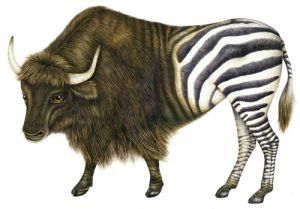
A yak isn’t just a big, fluffy beast; it’s a symbol of resilience. These animals thrive in some of the most unforgiving environments, making them fascinating subjects for anyone curious about nature and evolution. Think of the yak as a living testament to how species can adapt over time, reflecting changes in their environment and interactions with humans.
Origins of the Yak
The yak’s journey began in the high altitudes of the Tibetan Plateau, where it shares its ancestry with wild cattle. The yak, scientifically known as *Bos grunniens*, belongs to the Bovidae family, which includes animals like cows and bison. This family tree branches out over millions of years, showing how species migrated and evolved based on their surroundings.
Scientists believe that yaks diverged from their wild ancestors around 1 million years ago, specifically from the *Bos primigenius* lineage. This ancient breed adapted to the cold, thin air of the Himalayas, developing unique traits that made them incredibly suited for life at high elevations. You might be wondering what makes them so special. Well, yaks have thick fur, a layer of fat, and even respiratory adaptations that help them breathe in low-oxygen environments. These features are results of a long evolutionary process that has fine-tuned them for survival.
Physical Adaptations Over Time
Let’s talk about what makes yaks unique physically. Their thick, shaggy coats aren’t just for show. These coats provide warmth and protection against harsh weather conditions. In fact, the coat can grow to be quite long, helping to insulate them from the biting cold of their high-altitude homes, which can drop to -40 degrees Fahrenheit in winter!
Additionally, yaks possess a strong body structure and powerful legs, allowing them to traverse difficult mountain terrains with ease. Their hooves are broad and shaped, which helps them maintain grip on icy surfaces. You could say that yaks are built like tanks, equipped for a one-of-a-kind lifestyle that few other animals can match.
The Role of Yak in Human Culture
Now, here’s where it gets interesting. Yaks have been an integral part of human life in Tibet and surrounding areas for thousands of years. Imagine a community relying on these animals not just for their meat, but also for milk, wool, and even as pack animals! Yaks are like the Swiss Army knives of the Himalayan landscape—versatile and essential.
In many Tibetan cultures, yaks are revered. They are often featured in festivals and traditional ceremonies, symbolizing strength and endurance. The milk from yaks is fermented into a type of yogurt called *churpi*, popular among locals. Their dung is also used as fuel for cooking in the high altitudes where wood is scarce. This relationship illustrates a deep connection between humans and yaks that has evolved over centuries.
Wild vs. Domestic Yak
When discussing yaks, it’s important to differentiate between domestic and wild varieties. Domestic yaks, or *Bos grunniens*, are often found in herds and have been bred for specific traits to serve human needs, like producing more milk or wool. They tend to be less aggressive and more social.
On the other hand, the wild yak (*Bos mutus*) roams freely in the rugged mountains and is generally larger and more robust than its domestic counterpart. Wild yaks are elusive, often living at altitudes above 10,000 feet, where few humans venture. They’re known for their powerful horns and impressive physical stature, which help them fend off predators in the wild.
Conservation Efforts for Yaks
As fascinating as they are, yaks are facing threats due to climate change and habitat loss. The warming planet could impact their high-altitude environments, making it crucial for conservationists to step in. Efforts are being made to protect both wild and domestic yak populations through various means, including sustainable farming practices and habitat preservation initiatives.
You might wonder how you can help. Supporting organizations that focus on sustainable agriculture and wildlife conservation can make a difference. Additionally, raising awareness about the unique adaptations and cultural significance of yaks can foster appreciation and encourage protective measures.
Modern Significance of the Yak
In recent years, yaks have gained popularity beyond their traditional habitats. They are being introduced to other areas as eco-friendly livestock. Their ability to graze on tough terrain makes them valuable for sustainable farming. Yaks can help maintain pastures and reduce the need for chemical fertilizers due to their natural grazing habits.
Moreover, there’s been a rise in yak products in the global market. From wool to dairy, yaks are presenting new opportunities for sustainable businesses in regions where they thrive. This blend of ancient tradition and modern enterprise reflects how well yaks have evolved to meet both environmental and economic needs.
The Future of Yaks
Looking ahead, the future of yaks is tied to both their ecological role and human innovation. As climate change poses new challenges, continued research into their adaptability will be essential. Scientists are studying yaks to understand their unique physiology, which might provide clues for other livestock facing similar threats.
Moreover, as communities continue to rely on yaks, innovative practices in farming and conservation could emerge. Imagine more farmers embracing yak husbandry for its sustainability benefits. That could lead to a brighter future for both yaks and the people who depend on them.
The evolutionary history of the yak is a fascinating story of adaptation, survival, and the deep bond between humans and animals. From their origins in high-altitude regions to their role in modern agriculture, yaks exemplify resilience, making them an important part of both our natural world and human culture. As we move forward, it’s essential to ensure that these amazing animals continue to thrive for generations to come.
